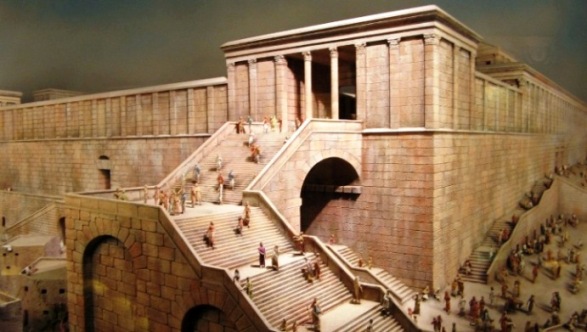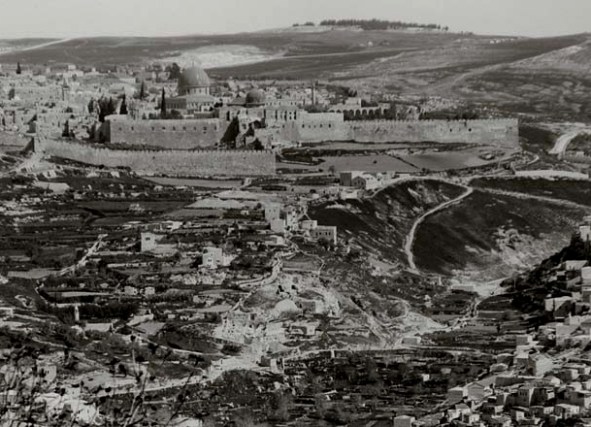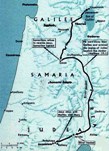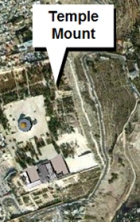Way of the Cross
The Way of the Cross: Via Dolorosa
Questions for Bible study groups
- Why couldn’t Jesus carry his cross to the place of execution?
- Who was Simon of Cyrene?
- Who were the women in the crowd, and what did they do?
- How did Jesus respond to them?
In brief: In his weakened state Jesus could not carry the cross. Simon of Cyrene helped him. A group of women in the crowded Jerusalem streets mourned for Jesus, the condemned man, already close to death.
Simon of Cyrene carries the cross
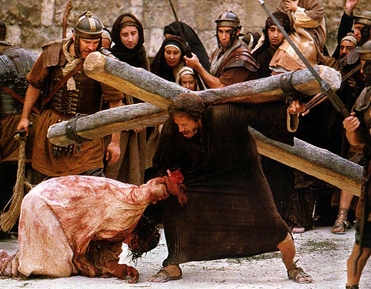 Jesus and two other condemned men were taken by soldiers from the praetorium in Jerusalem to the place of execution.
Jesus and two other condemned men were taken by soldiers from the praetorium in Jerusalem to the place of execution.
A condemned man usually carried the cross to the place of execution, but Jesus was so exhausted and weakened by the beatings that by the time they came near the city gate, a passer-by was hauled in to help carry the crossbar.
This horizontal piece of the cross (not the whole cross as shown in traditional paintings or in the film still at right) was usually carried by a condemned prisoner to the place of execution. The fact that Jesus had to be helped seems to indicate that he had fallen and been unable to rise again to his feet, even at the brutal urging of the soldiers.
Who was Simon of Cyrene?
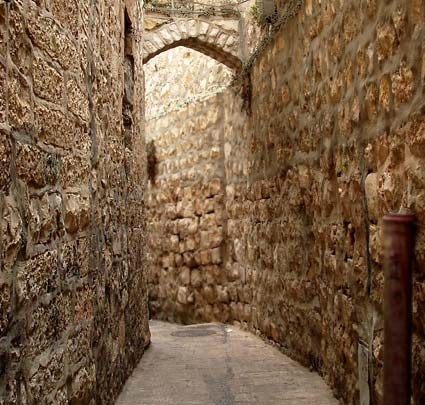 The man who helped him, Simon of Cyrene, came from North Africa. Cyrene had a large colony of Jews – the Jewish historian Josephus notes a Jewish community in Cyrene (Against Apion 2.44, Antiquities 16:169) and Simon must have been one of them, travelling to Jerusalem as a pilgrim to celebrate the feast of Passover.
The man who helped him, Simon of Cyrene, came from North Africa. Cyrene had a large colony of Jews – the Jewish historian Josephus notes a Jewish community in Cyrene (Against Apion 2.44, Antiquities 16:169) and Simon must have been one of them, travelling to Jerusalem as a pilgrim to celebrate the feast of Passover.
His sons are also mentioned in the gospel narrative. This must mean that later on they became well-known members of the early Christian church.
His son Rufus may even be the same Rufus who appears in Romans 16:13, where Paul writes ‘Greet Rufus, chosen in the Lord; and greet his mother, a mother to me also.’ It is tempting to think that Simon’s action in helping Jesus had repercussions for the whole family, even after Simon himself died, and that his wife and sons were drawn into the greater Christian family.
See the blue text in What The Gospels Say at end of page
The women of Jerusalem mourn for Jesus
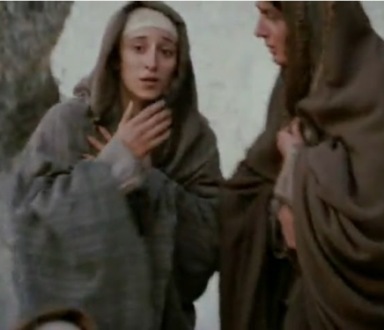 The narrow streets leading to the place of execution were densely crowded. People were naturally curious to see a man passing to his execution, and in fact the sight of a tortured man on his way to a cruel death was meant to intimidate them and act as a deterrent.
The narrow streets leading to the place of execution were densely crowded. People were naturally curious to see a man passing to his execution, and in fact the sight of a tortured man on his way to a cruel death was meant to intimidate them and act as a deterrent.
Among this crowd were a group of women who raised an anguished death-wail for Jesus. But Jesus responded with words that were, in effect, a death-wail for Jerusalem. He urged them not to pity him but to pity themselves, for a day was coming when they would rue having children.
His words echo the opening words of Isaiah 54: ‘Sing O barren woman who never bore a child…’ Barrenness and childlessness were seen as a curse among the Jews, but if this was how the Romans treated an innocent man, how much worse would be the fate of rebellious Jerusalem in the years ahead. If these women bore children they would have to contend not only with their own suffering, but with the sufferings of their children. People would long for death to free them.
Were these women from Jesus’ extended family, or Galilean disciples and friends? It’s probable, but impossible to tell for sure. We assume they must have known him well to have felt such grief and horror.
See the green text in What The Gospels Say at end of page
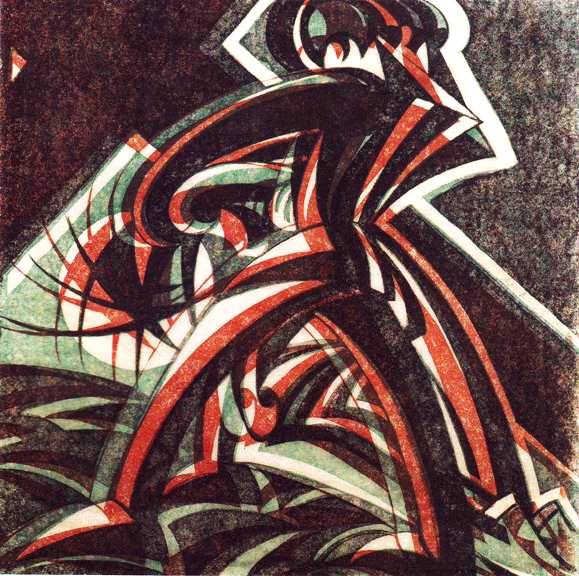
Jesus Falls the First Time, Station III of the Way of the Cross, Sybil Andrews, 1962
This picture captures the juddering sound of the heavy cross hitting the stone road
Return to top
What the Gospels say
1 Simon of Cyrene helps Jesus: Read the blue text
2 The women of Jerusalem mourn: Read the green text
Matthew 27:32
As they went out, they came upon a man of Cyrene, Simon by name; they compelled this man to carry his cross.
Mark 15:21
21 And they compelled a passer-by, Simon of Cyrene, who was coming in from the country, the father of Alexander and Rufus, to carry his cross.
Luke 23:26-32
26 As they led him away, they seized a man, Simon of Cyrene, who was coming in from the country, and they laid the cross on him and made him carry it behind Jesus.
27 And a great number of people followed him , and among them were women who beat their breasts and wailed for him. 28 But Jesus turning to them said, “Daughters of Jerusalem, do not weep for me, but weep for yourselves and for your children. 29 For behold, the days are coming when they will say, ‘Blessed are the barren, and the wombs that never bore, and the breasts that never gave suck!’ 30 Then they will begin to say to the mountains, ‘Fall on us’; and to the hills, ‘Cover us.’ 31 For if they do this when the wood is green, what will happen when it is dry?”

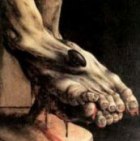
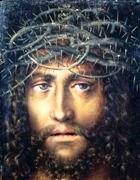
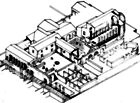
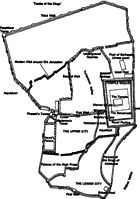
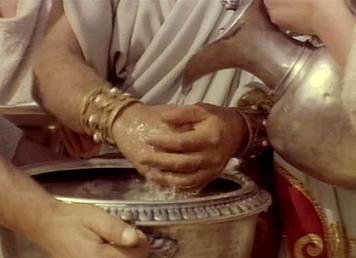 Why did the crowd in Jerusalem choose Barabbas, not Jesus? Because Barabbas, a political terrorist and criminal, was the Sanhedrin’s preferred candidate.
Why did the crowd in Jerusalem choose Barabbas, not Jesus? Because Barabbas, a political terrorist and criminal, was the Sanhedrin’s preferred candidate. 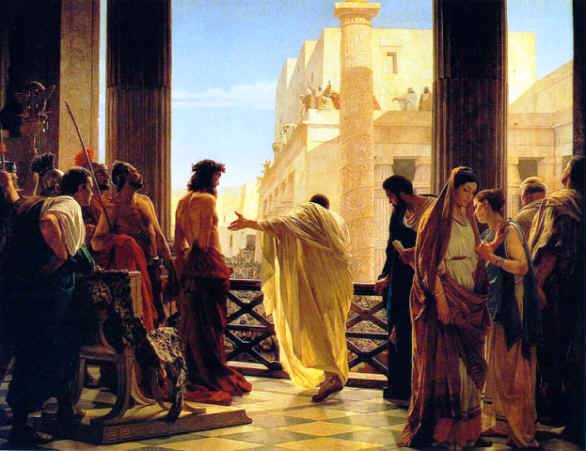
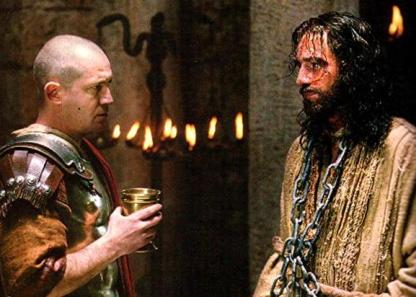 Both Philo (a philosopher) and Josephus (a Jewish historian) make it clear that Pilate detested the Jews. Whenever he had to deal with them he inevitably took the opposite position to what they wanted. He did this when the Sanhedrin brought Jesus to him.
Both Philo (a philosopher) and Josephus (a Jewish historian) make it clear that Pilate detested the Jews. Whenever he had to deal with them he inevitably took the opposite position to what they wanted. He did this when the Sanhedrin brought Jesus to him.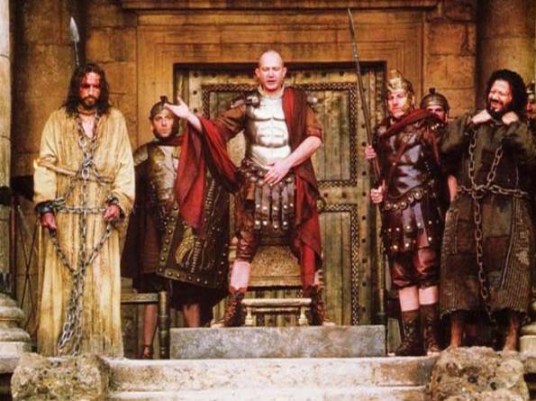
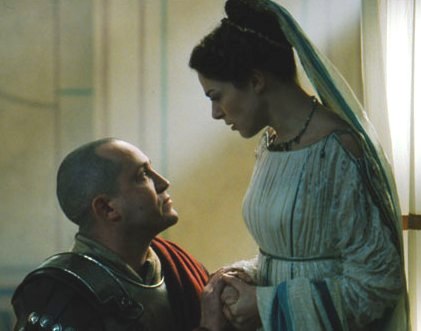 Given the choice between Jesus, a social/religious reformer, and a festival riot in Jerusalem, Pilate decided that one death was better than a possible revolt – and all the deaths that would cause. He succumbed to Jewish pressure.
Given the choice between Jesus, a social/religious reformer, and a festival riot in Jerusalem, Pilate decided that one death was better than a possible revolt – and all the deaths that would cause. He succumbed to Jewish pressure.

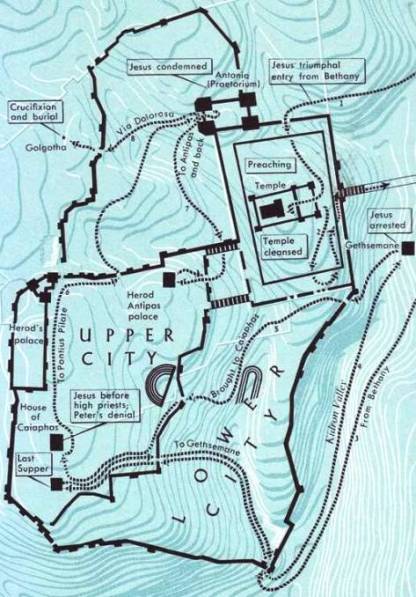
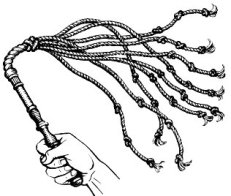 It is fairly clear that Pontius Pilate tried to save Jesus by offering the crowd an unattractive alternative, Barabbas. As we know, this ploy failed.
It is fairly clear that Pontius Pilate tried to save Jesus by offering the crowd an unattractive alternative, Barabbas. As we know, this ploy failed.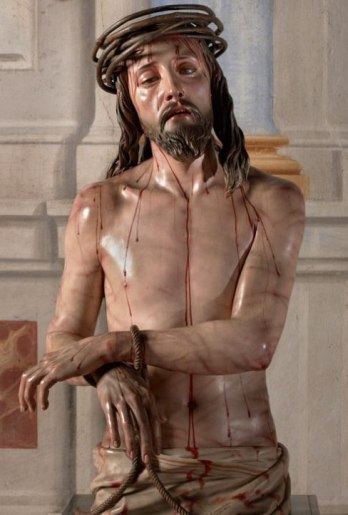
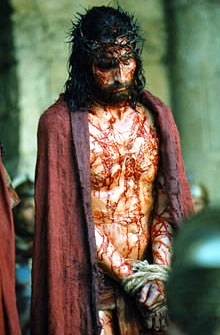 They wove spiky twigs into a rough crown and set it on his head.
They wove spiky twigs into a rough crown and set it on his head.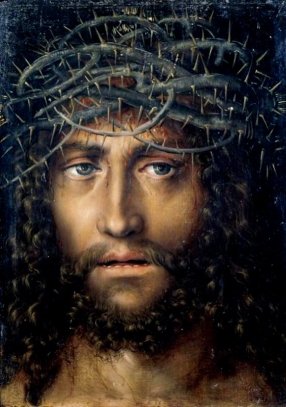
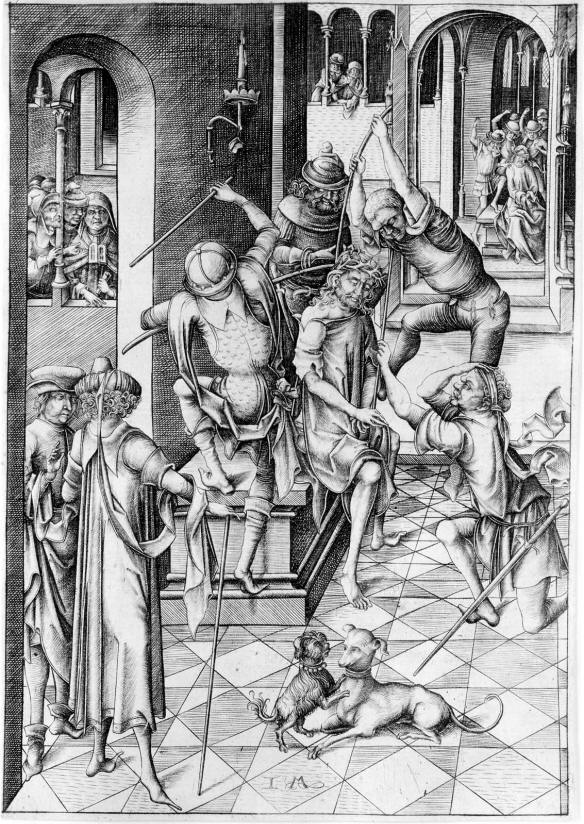
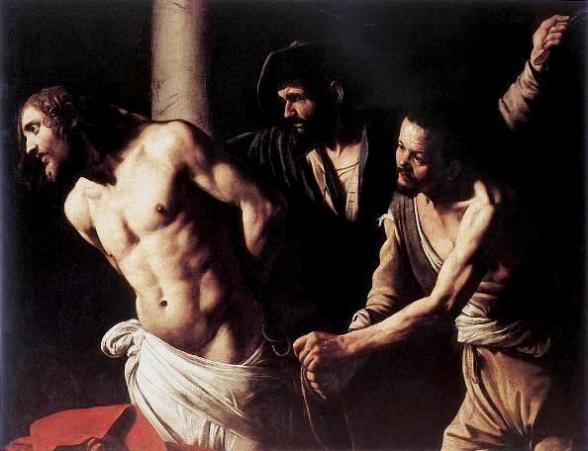
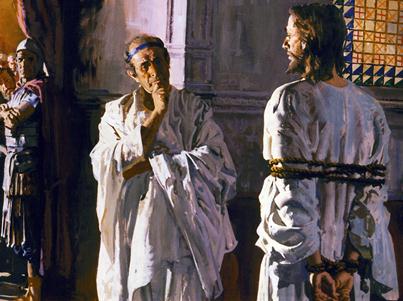 When: the working day of a Roman official began as soon as it was daylight, and we know that trials in the forum in Rome began just after sunrise. So it was necessary for the Sanhedrin to bring Jesus to Pilate at this early hour if they wanted sentence to be passed that day – as they did.
When: the working day of a Roman official began as soon as it was daylight, and we know that trials in the forum in Rome began just after sunrise. So it was necessary for the Sanhedrin to bring Jesus to Pilate at this early hour if they wanted sentence to be passed that day – as they did.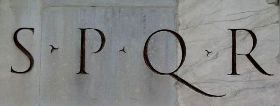 So Jesus was bound and led through Jerusalem from the house of Caiaphas, where he had spent the last part of the night, to the strongly fortified palace of the Herods. It was not a long walk. Houses of wealthy Jewish citizens like Caiaphas lay close to the Roman administrative centre.
So Jesus was bound and led through Jerusalem from the house of Caiaphas, where he had spent the last part of the night, to the strongly fortified palace of the Herods. It was not a long walk. Houses of wealthy Jewish citizens like Caiaphas lay close to the Roman administrative centre.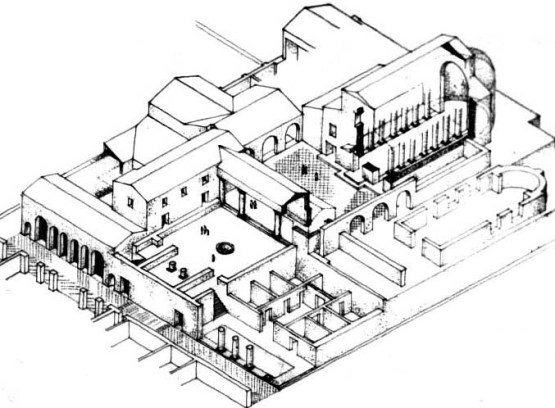
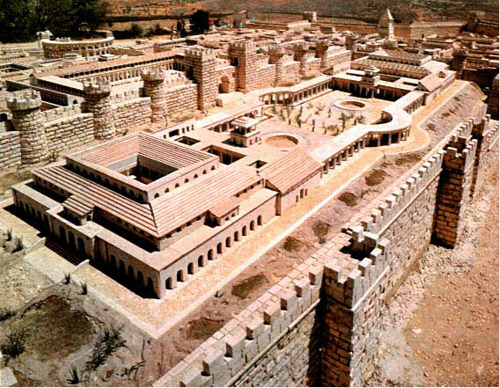
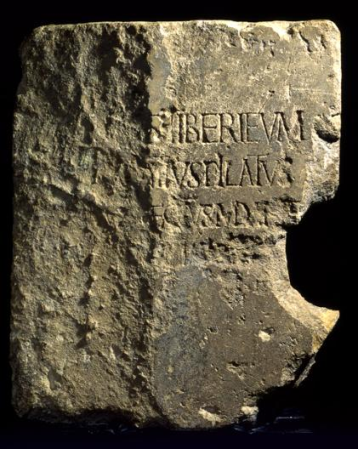
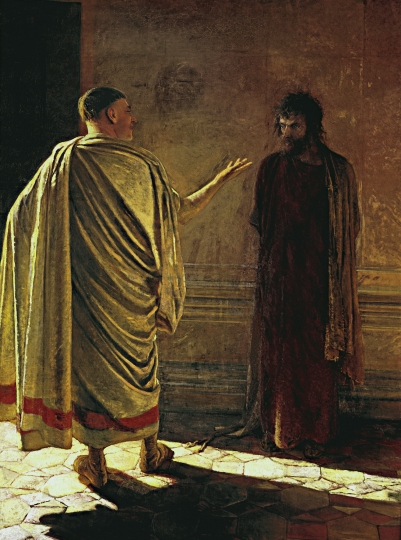

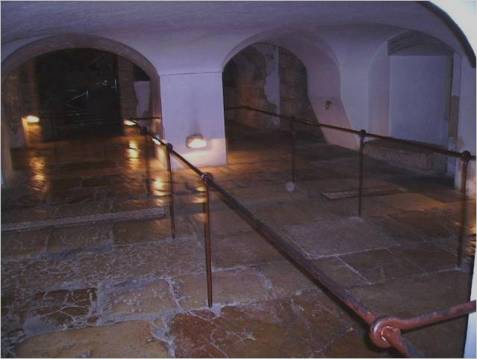
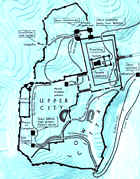
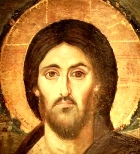

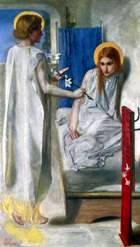
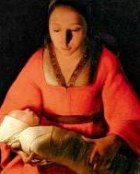
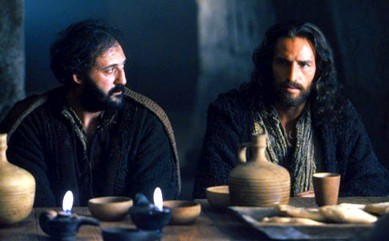 Peter is the most lovable and human of the disciples, as this story shows, but he has flaws as well. Perhaps that is why Jesus chose him to lead the early Church.
Peter is the most lovable and human of the disciples, as this story shows, but he has flaws as well. Perhaps that is why Jesus chose him to lead the early Church.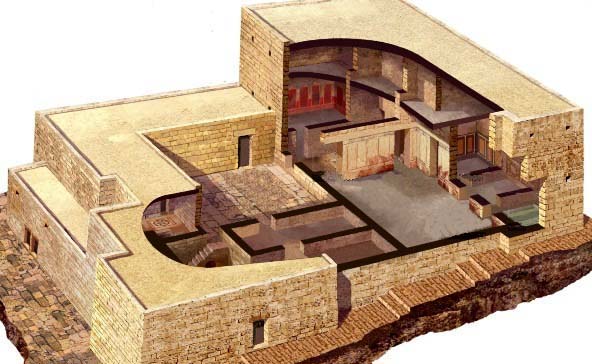
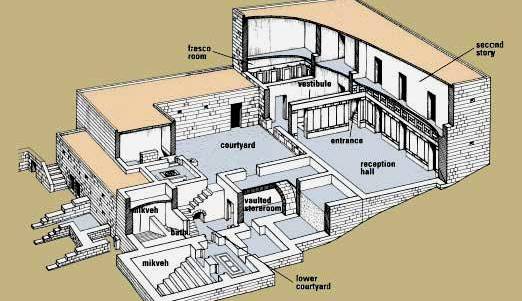
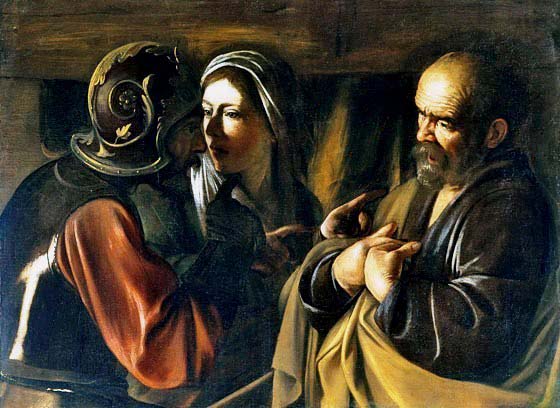
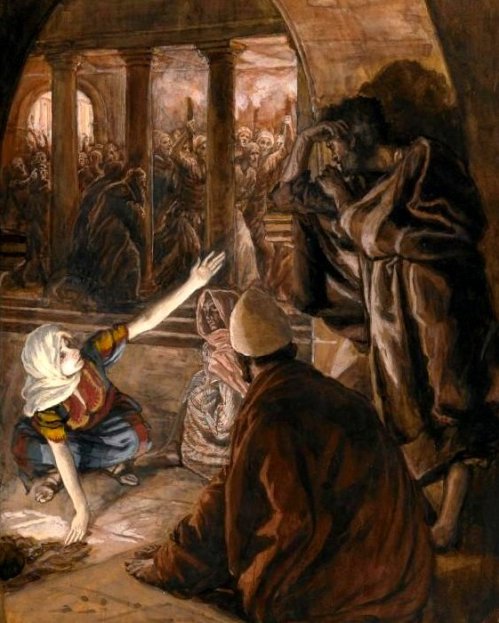
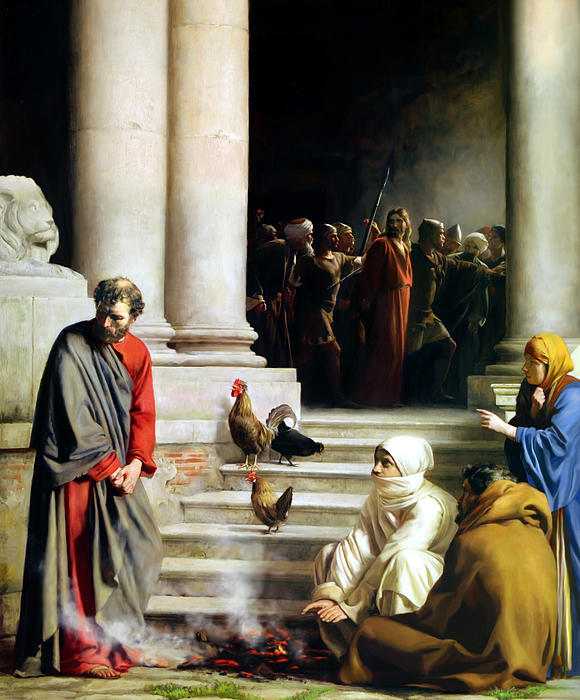

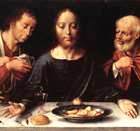
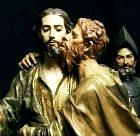
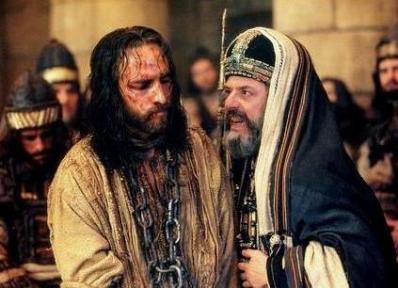
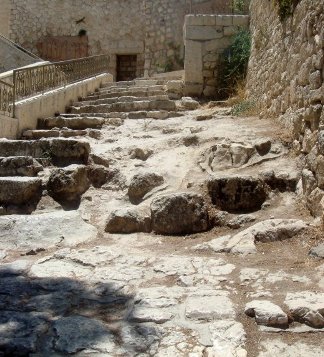 The Jewish authorities had been in conflict with Jesus for some time, but had done nothing other than challenge him in debate.
The Jewish authorities had been in conflict with Jesus for some time, but had done nothing other than challenge him in debate.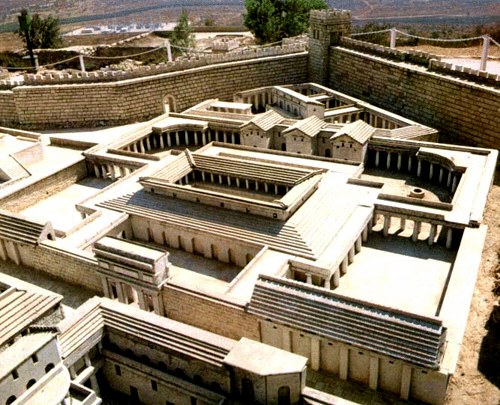
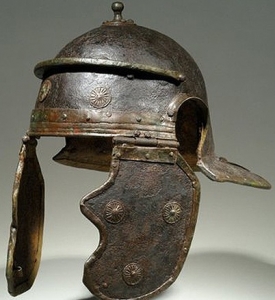 At the end of this hearing some members of the Sanhedrin, possibly furious at this intrusion into the Passover ceremonies, showed their contempt and anger by spitting at Jesus and striking him.
At the end of this hearing some members of the Sanhedrin, possibly furious at this intrusion into the Passover ceremonies, showed their contempt and anger by spitting at Jesus and striking him.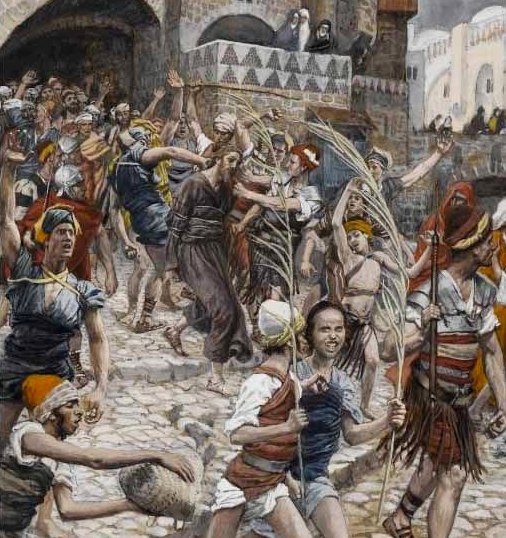
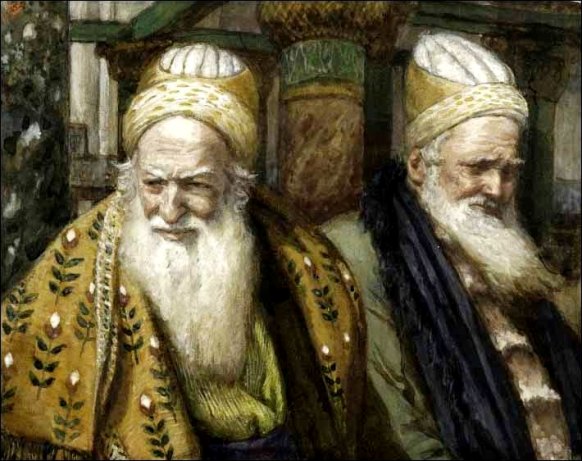


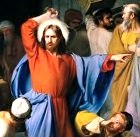
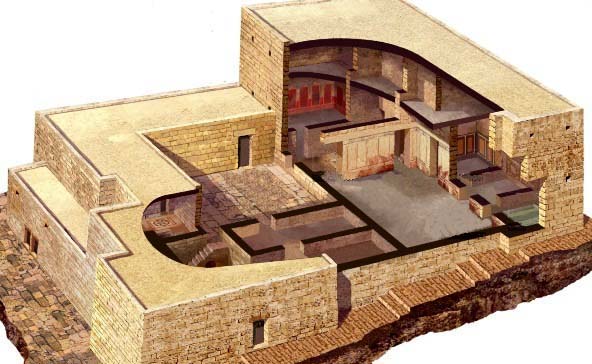
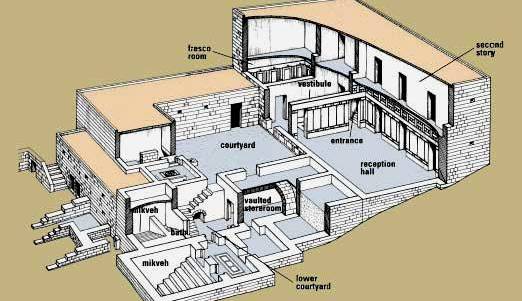
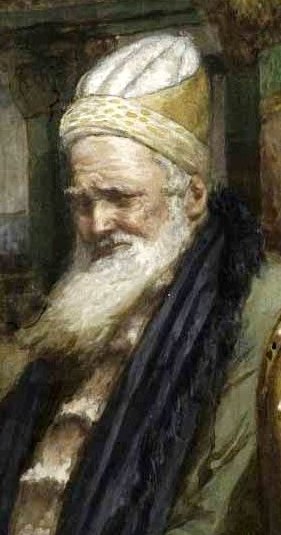 In the preliminary questioning of Jesus, Annas tried to gather evidence that could later be presented at a formal hearing before the members of the Sanhedrin.
In the preliminary questioning of Jesus, Annas tried to gather evidence that could later be presented at a formal hearing before the members of the Sanhedrin.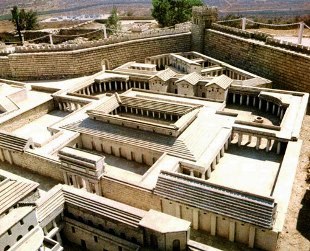 But this incident with Annas was not part of a formal trial. It was a quick enquiry, late at night, in an emergency situation. It may have taken only a few minutes, after which Jesus was hustled out into the darkness – see the courtyard and anterooms in the model of Annas’ house (above), where the questioning took place.
But this incident with Annas was not part of a formal trial. It was a quick enquiry, late at night, in an emergency situation. It may have taken only a few minutes, after which Jesus was hustled out into the darkness – see the courtyard and anterooms in the model of Annas’ house (above), where the questioning took place.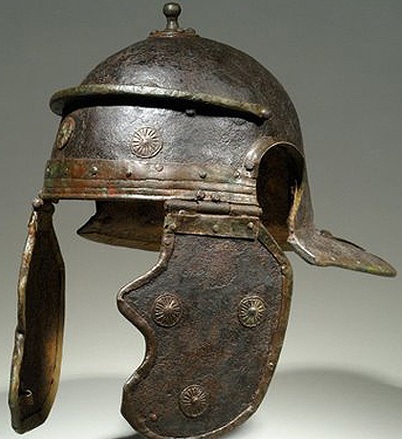 One of the onlookers, a soldier, struck Jesus with his hand (the word in the original text, rhapisma, means a sharp blow with the flat of the hand.) This action began the cycle of violence that would end with Jesus’ death.
One of the onlookers, a soldier, struck Jesus with his hand (the word in the original text, rhapisma, means a sharp blow with the flat of the hand.) This action began the cycle of violence that would end with Jesus’ death.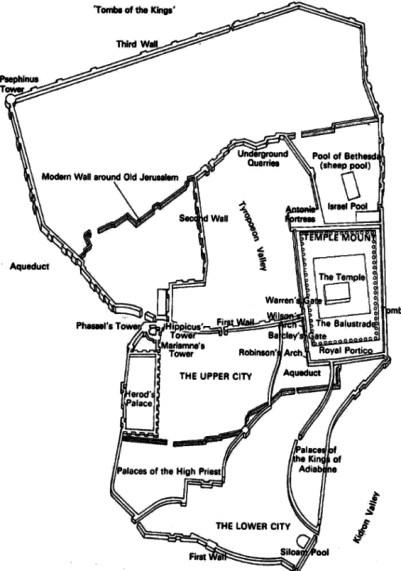
 1 Jesus is taken to Annas: Read the blue text
1 Jesus is taken to Annas: Read the blue text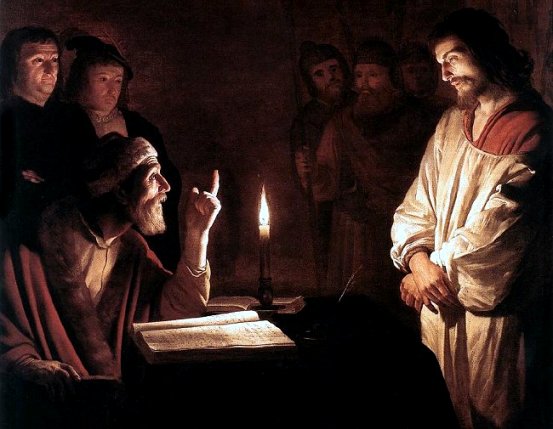

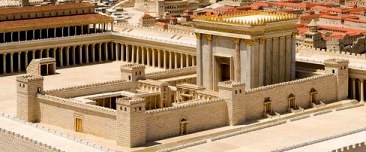


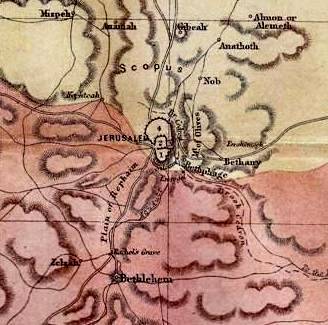
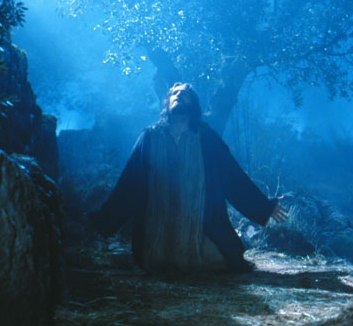 Jesus was praying not just to avoid a terrible death, but to discover God’s will and to find the strength to cope with what was coming; he was providing a concrete example of the value of prayer
Jesus was praying not just to avoid a terrible death, but to discover God’s will and to find the strength to cope with what was coming; he was providing a concrete example of the value of prayer Emotionally exhausted, Jesus turned to his disciples, the very ones who had been so adamant at the Last Supper that they would stand by him. They had fallen asleep.
Emotionally exhausted, Jesus turned to his disciples, the very ones who had been so adamant at the Last Supper that they would stand by him. They had fallen asleep.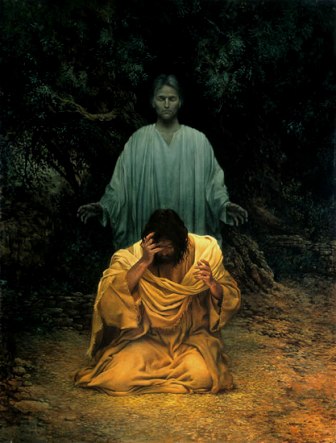 As he prayed, an ‘angel’ had come to him, giving him strength. Only this, God’s direct response, can account for the transformation that follows. He had been terrified of the future and had prayed. Now in the final moments in the garden, he was suddenly strong, resolute. He had asked God to save him from death. God’s strengthening angel has responded, giving him courage to face what was coming.
As he prayed, an ‘angel’ had come to him, giving him strength. Only this, God’s direct response, can account for the transformation that follows. He had been terrified of the future and had prayed. Now in the final moments in the garden, he was suddenly strong, resolute. He had asked God to save him from death. God’s strengthening angel has responded, giving him courage to face what was coming.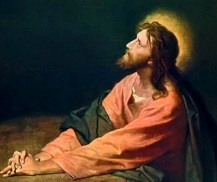

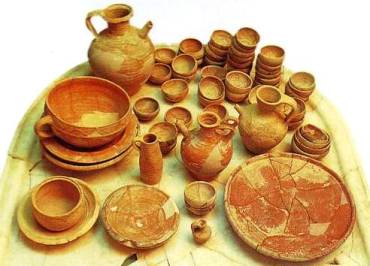
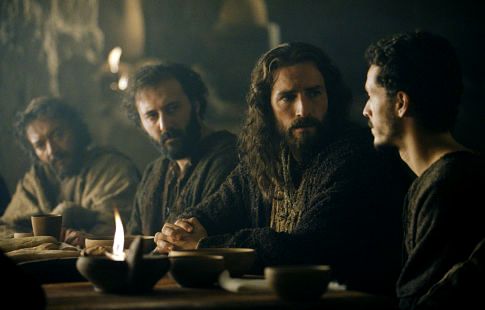
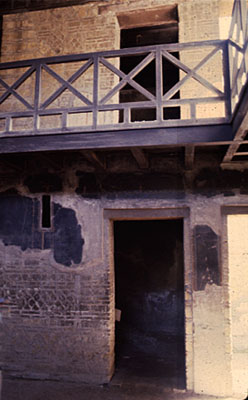
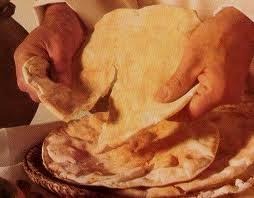 Jesus performed the action of the head of the household at any ordinary Jewish meal.
Jesus performed the action of the head of the household at any ordinary Jewish meal. 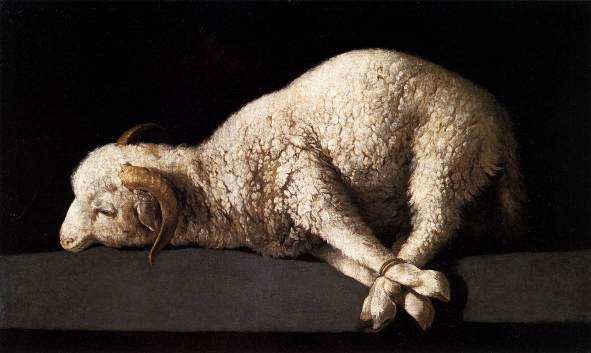
 Jesus took basic elements of human sustenance, food and drink, and blessed them. Then he turned the commemoration of this event into a symbolic communion with the redemptive power of his own death.
Jesus took basic elements of human sustenance, food and drink, and blessed them. Then he turned the commemoration of this event into a symbolic communion with the redemptive power of his own death.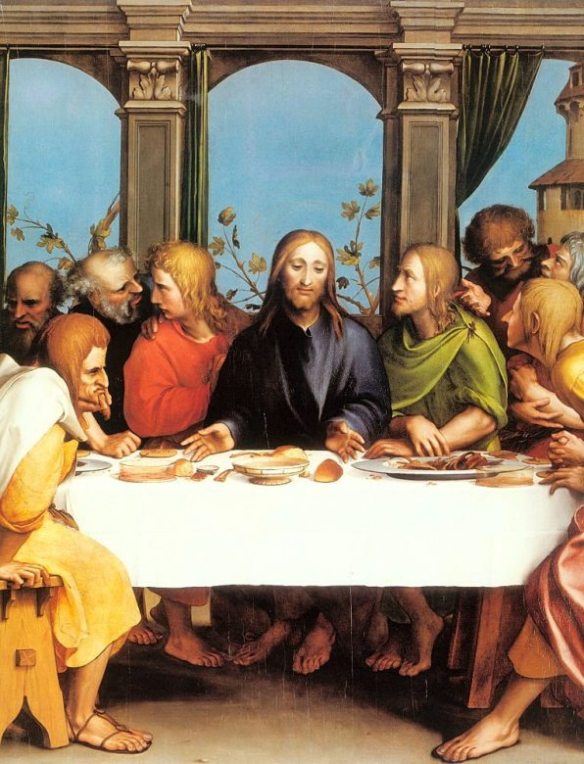
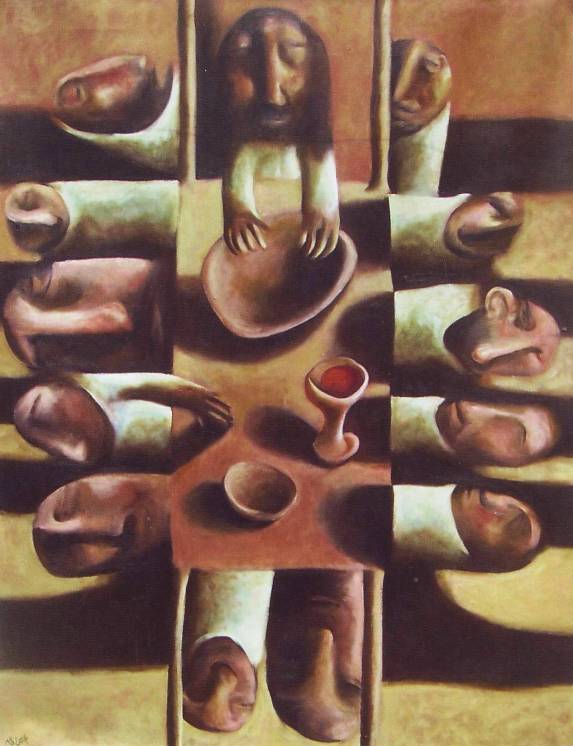
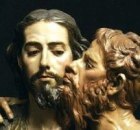
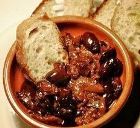
 There was a market there selling sacrificial animals and birds. There was also a money exchange, since the Temple dues had to be paid in Tyrian coinage, and most people had Jerusalem coinage only. This meant:
There was a market there selling sacrificial animals and birds. There was also a money exchange, since the Temple dues had to be paid in Tyrian coinage, and most people had Jerusalem coinage only. This meant: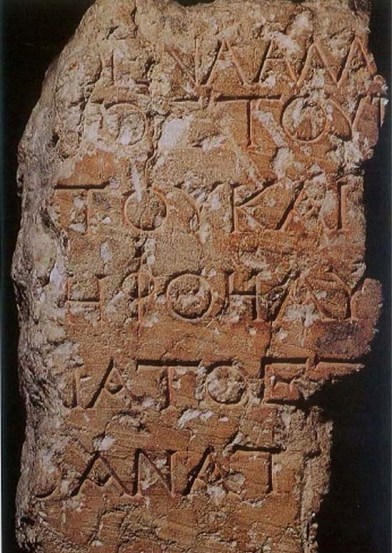 At right is an excavated stone sign found at the site of the Temple of Jerusalem. It advises that Gentiles must not enter past this point, on pain of death, and was presumably at the entrance separating the Court of the Women from the Court of the Gentiles (see ground plan below).
At right is an excavated stone sign found at the site of the Temple of Jerusalem. It advises that Gentiles must not enter past this point, on pain of death, and was presumably at the entrance separating the Court of the Women from the Court of the Gentiles (see ground plan below).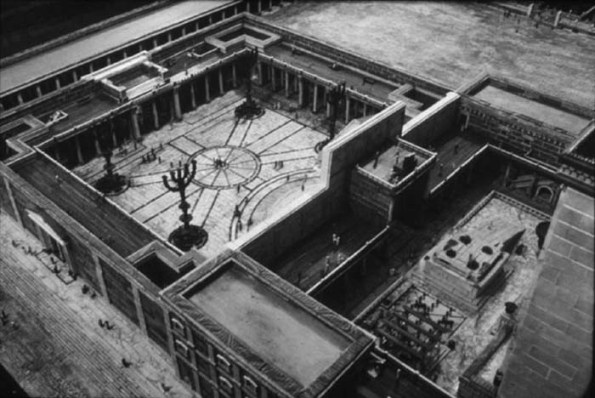
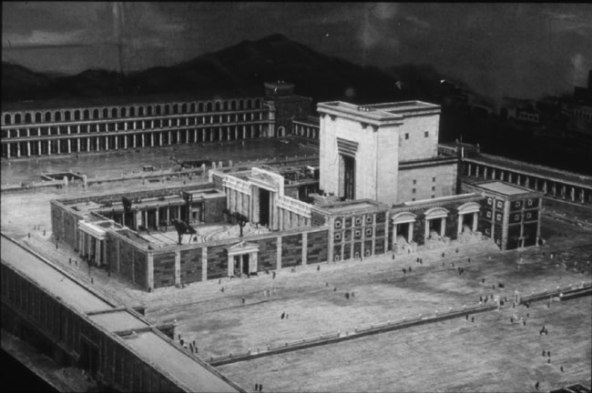
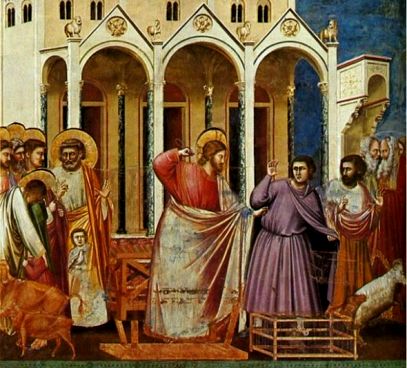 But the scale of what happened is unimportant, both to us and to the disciples who witnessed it. Its real significance lay in two things:
But the scale of what happened is unimportant, both to us and to the disciples who witnessed it. Its real significance lay in two things: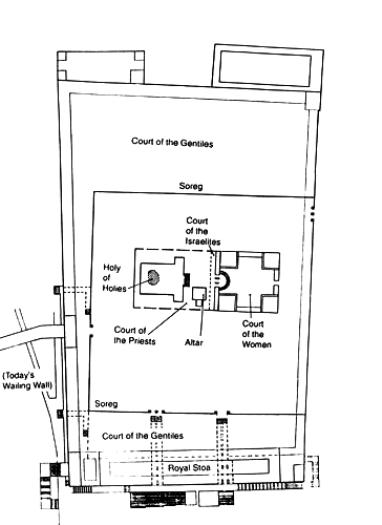 What Jesus said at the time is as important as what he did. He was objecting to trade being carried out in the Temple not because of profiteering, but because the Temple precincts have been turned into a place of business, thus violating its divinely intended purpose. He bases this on the words of the prophet Isaiah ‘my house shall be called a place of prayer’. Now it is a ‘den of thieves’- again, a phrase from another prophet, Jeremiah 7:11.
What Jesus said at the time is as important as what he did. He was objecting to trade being carried out in the Temple not because of profiteering, but because the Temple precincts have been turned into a place of business, thus violating its divinely intended purpose. He bases this on the words of the prophet Isaiah ‘my house shall be called a place of prayer’. Now it is a ‘den of thieves’- again, a phrase from another prophet, Jeremiah 7:11.